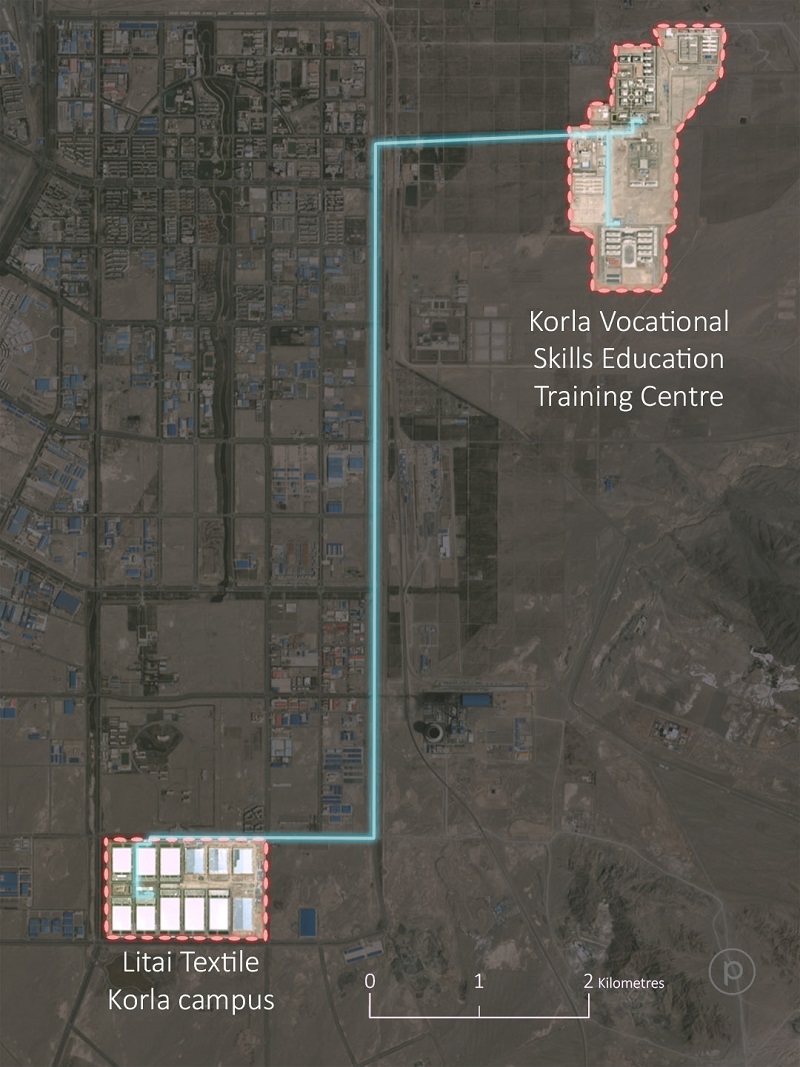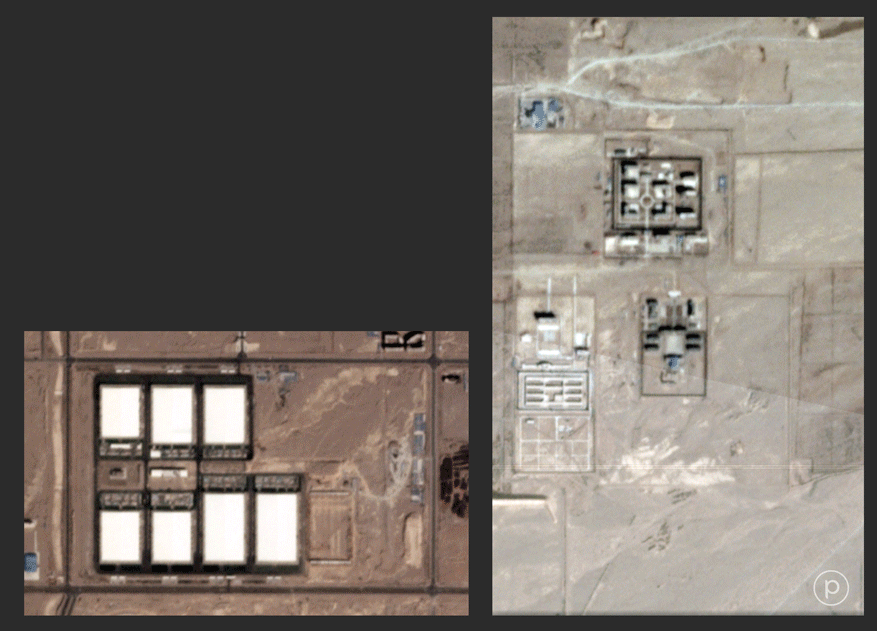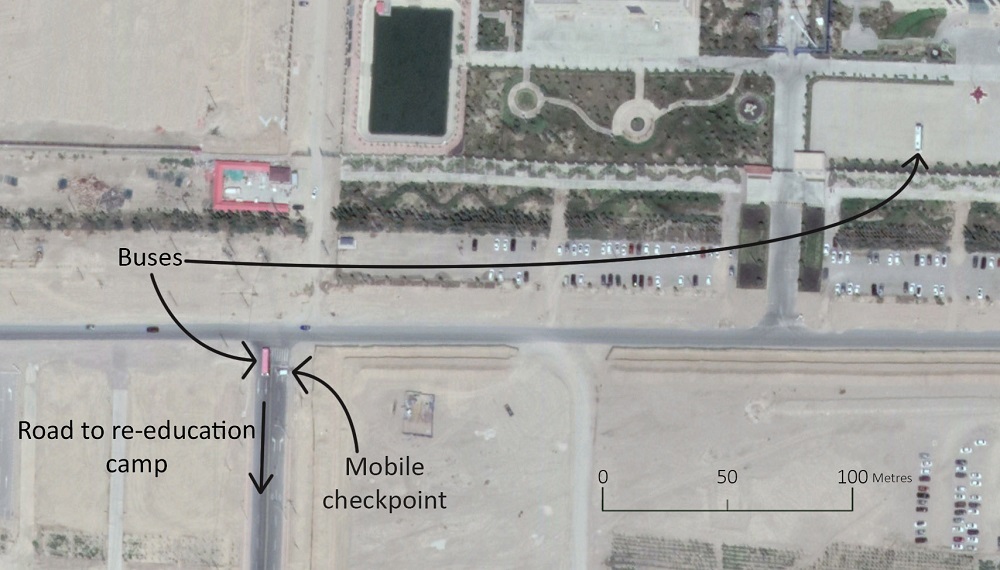
In September 2018, Australian clothing chain Cotton On sent representatives to Xinjiang in western China to assess a large textile facility in the Korla industrial zone run by the China-based Litai Textile Group. As uncovered by an ABC Four Corners investigation, Cotton On subcontracts Litai Textile to supply it with yarn.
Analysis of open-source data suggests that the factories managed by Litai Textile may be at risk of engaging in labour coercion and unfair labour practices relating to the arbitrary detention of ethnic and religious minorities in Xinjiang.
Chinese government notices regarding Litai Textile–run factories show that the company has been working closely with local government officials in Xinjiang to recruit and train labourers to work in its facilities. These notices appear to refer to the sort of re-education ‘graduation streams’ identified by German academic Adrian Zenz, whereby detainees are integrated into various vocational labour industry streams following their ‘graduation’ from an extended period of political indoctrination and re-education. These labourers may be housed in the factory complex or remain in the re-education camps.
About 6 kilometres from the Litai Textile factory complex lies the ‘Korla Vocational Skills Education Training Centre’—a series of new compounds that appear to include detention facilities and prisons, as well as a ‘re-education’ camp (Figure 1). Satellite evidence reveals that the re-education facility in Korla was largely constructed after the start of Xinjiang’s latest crackdown in early 2017 and consists of several big building wings with varying levels of security.
Since April 2018, fleets of large buses have been regularly present at both locations.
While satellite imagery cannot definitively confirm the movement of people between these facilities, developments like this should act as warning signs for companies doing business in Xinjiang that their supply chains may contain companies that could be associated with unfair or coercive labour practices.
Figure 1: The Korla industrial zone showing the Litai Textile factories and the Korla ‘re-education’ facility, the assumed bus route between them, and observed bus parking sites

Source: Satellite imagery from June 2019, courtesy of Planet Labs.
An estimated 1–1.5 million people from ethnic and religious minorities are currently being arbitrarily detained in a sprawling network of prisons, detention centres and ‘re-education’ camps in Xinjiang. These human rights abuses were called out by 22 nations—including Australia—late last week in a joint statement to the UN Human Rights Council.
The 2018 Cotton On visit to the Litai Textile factory complex occurred when Australian diplomatic staff were refused access to Xinjiang, a situation that remains unchanged today. At least one Australian citizen and around 17 Australian permanent residents are believed to be currently detained in Xinjiang—either held in detention centres, under house arrest or under restricted movement orders that mean they can’t travel to Australia. The entire Uyghur population in Xinjiang is subject to extreme surveillance and restriction of movement—and has been for years—with few having full access to, or use of, their passports.
The situation in Xinjiang is extremely opaque and investigation of what is occurring there is difficult. But collection and analysis of open-source information, including satellite imagery, provide an alternative window into what is happening on the ground.
For example, satellite imagery provides unique insights into the increasingly securitised nature of the region. The Chinese Communist Party has placed strict and coercive controls on individual freedoms, including even the most basic rights to freedom of movement, including for visitors.
In the case of the industrial zone that houses both the Korla training centre and the Litai Textile factories, satellite evidence shows that both have expanded over the past two years. The textile factories expanded rapidly, growing to almost twice their original size during 2018. Those expansions followed other additions in 2017, which included new transport infrastructure including a car park.
The factory expansion coincided with the expansion of the Korla Vocational Skills Education Training Centre (Figure 2). These two separate significant expansions constitute the only major construction in the industrial park since 2017.
Figure 2: Synchronised time lapse of the two facilities between May 2017 and May 2019

Source: Imagery courtesy of Planet Labs.
In mid-2017—while two additional buildings were being added to the Korla training centre—a large car park was built at the centre of the Litai Textile factory complex. The new parking area remained empty for five months after its completion. Then, in April 2018, buses start appearing and can be seen consistently parked in this new area.
Of the 96 commercial satellite images collected and analysed after April 2018, all but one show buses occupying the new, previously empty, car park—during the week and on weekends—at the expanded factory complex.
Buses of similar size, shape and colours are also regularly present in the car park of the Korla training centre. The buses park closest to what is assumed to be the re-education camp component of the facility. In some satellite images, these buses can be seen driving through closed roads within the alleged re-education camp that are blocked off to regular traffic by a checkpoint (Figure 3).
Figure 3: Buses in the Korla industrial zone, 26 August 2018—a bus is parked in an internal parking lot of the re-education camp and a second (red) bus can be seen south of the re-education camp complex on a road blocked to regular traffic

Source: Imagery courtesy of Maxar, via Google.
The satellite evidence on its own is not enough to prove that coerced labour is definitely being used in these factories. The buses at both locations, for example, cannot be definitively linked. Nor can the nature of the labour force used in the factories be ascertained from satellite imagery alone.
However, the dual expansions—along with the sudden and constant appearance of similar coloured buses—at the very least highlight two key new developments on the ground. First, the satellite footage indicates that detainees are regularly being transported into and out of the re-education facilities in which they are detained. Second, the imagery indicates that, since April 2018, buses are moving people into and out of the textile factories—factories that count Australian companies among their client list.
Many Australian companies include Xinjiang in their supply chains, and the Four Corners investigation also looked at the business practices of other Australian companies and multinationals, including Target and IKEA.
Mass human rights abuses in Xinjiang—including coercive labour practices in the region—raise tough questions for Western companies operating there. Beyond the moral and ethical imperatives, several pieces of legislation—including Australia’s Modern Slavery Act 2018—require companies to report on the risk of, and measures to mitigate, the use of forced labour. Cotton On’s modern slavery and transparency statement and ethical sourcing program state that the company is committed to upholding the ‘human rights of all workers’.
Adrian Zenz told the ABC that it will soon become impossible to determine whether products manufactured or sourced in Xinjiang are made with coerced labour.
In response to the Four Corners investigation, Cotton On and Target Australia have said they are now investigating their relationships with suppliers in Xinjiang. Cotton On has stated that it will now undertake an investigation into allegations of coercive labour practices with its Xinjiang-based subcontractors and review the visit by its representatives to the region.
Through the analysis of open-source materials and commercial satellite imagery, it’s possible to detect clear warning signs that subcontractors are potentially at risk of using coerced labour. Regardless of what companies might be told by subcontractors, conducting any business in Xinjiang carries an elevated risk of being party to improper labour practices. All companies that source goods in the region should conduct robust and evidence-focused internal auditing of their supply chains.

